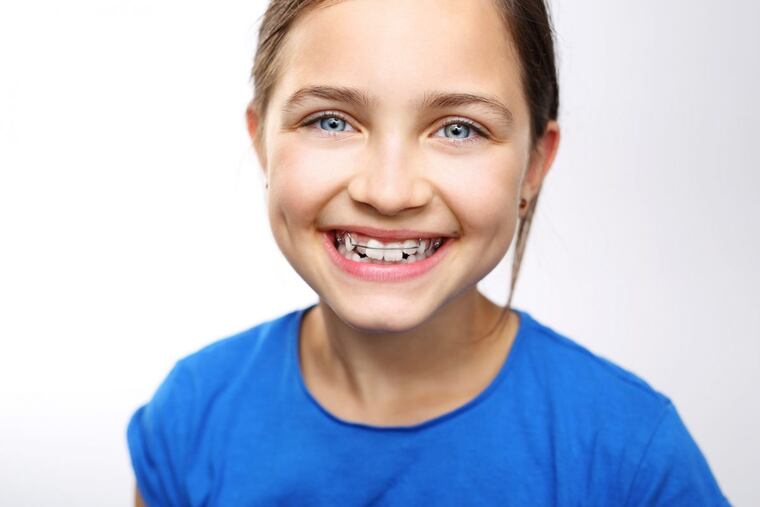What's the latest in orthodontic care?
We checked in with Neil Uffner, DMD, MS, from Broad Street Braces to get the latest on treatment options for kids and teens.

While orthodontists for years have checked for the same issues, braces have come a long way compared to when you may have worn them. Not only that, did you know that some kids may require two phases of treatment? We checked in with Neil Uffner, DMD, MS, from Broad Street Braces to get the latest on treatment options for kids and teens.
When do you recommend parents bring their child in to the orthodontist?
The American Association of Orthodontists recommends all children see an orthodontist by age 7. By then, enough permanent teeth have come in for an orthodontist to evaluate the bite. Also by this age, the relationship between upper and lower jaw growth starts to become apparent, and an orthodontist can began to identify problems.
What do you look for in an initial visit?
There are several things we look for at an initial visit. First, we take a panoramic X-ray which allows us to see the development of all the adult teeth at once. We check for missing teeth, extra teeth, malformed teeth, impacted teeth, and even other potential problems like cysts and tumors.
We then evaluate the patient's jaw growth. We look for: Are the right and left side of each jaw growing symmetrically? Are the top and bottom jaws growing at the same rate, or is one growing faster than the other? Is the top jaw wider than the bottom jaw, as it should be, or vice versa?
Then we examine the teeth. We check for:
spacing or crowding
early or late loss of baby teeth
enough space for the adult teeth to erupt.
proper front teeth alignment
the front teeth touch when the back teeth meet
there is no excessive overbite or speech problems.
Lastly, we look for habits which can be detrimental to dental development, like thumb sucking or a tongue thrust.
Has it been a trend recently that kids are getting braces at a younger age?
We are routinely asked this by parents. Generally speaking, there are two approaches for timing orthodontic treatment. The first approach, which I refer to as Conventional Treatment, is when we wait until all or nearly all of the permanent teeth have erupted— typically between ages 11-13. This treatment includes braces on all the teeth and can take anywhere from 12-30 months.
The second approach, called Two-Phase Treatment, as the name suggests is when treatment is rendered at two separate times. There are certain instances when Two-Phase treatment is a must. If there are underlying skeletal problems, such as a narrow upper jaw, an underbite, or a severe overbite, intercepting these problems when a patient is younger helps guide the growth of the facial and jaw bones. Without early treatment, these disharmonies worsen overtime and become more complicated to treat.
The first phase begins around age 8, lasts about 12 months, and often includes a combination of braces and a palate expander, a therapy used to widen the upper jaw. The patient is then given a retainer and takes a "braces vacation". Once all the permanent teeth have erupted, a second set of braces is used to align the teeth. When you see children getting braces at a younger age, it is usually because they are in the first phase of a Two-Phase Treatment. Other examples of when starting treatment earlier may be suggested are when patients have thumb sucking habits, or have very severe crowding or spacing concerns.
How common is it that kids will need two phases of treatment?
As long as there are no underlying skeletal problems, detrimental habits, or severe crowding or spacing concerns, most children are best treated conventionally, with one set of braces, typically between the ages of 11-13. In our office, one out of every five patients require two phases of treatment.
What's new with treatment options for kids and teens?
Oh boy, where to start! I think the biggest advancement the last several years and moving forward is what I like to call Clear Aligner Therapy such as Invisalign. This technology has been available to adults for some time, but starting to catch on teens less interested in wearing braces.
In our office, we are able to take a scan of a child's teeth, print digital models, and create custom clear aligners all in house, making this treatment more convenient, affordable, and accessible, than ever before. Do-it-yourself versions of clear aligned therapy are now also increasing in popularity, but I would be very cautious with these solutions, which often do not involve a consultation with a doctor. Braces themselves have evolved over the last several years too. We now have braces available, called self-ligating braces, that maintain their active forces longer than traditional braces, which means we can see patients every 10-12 weeks, as opposed to every four to six weeks.